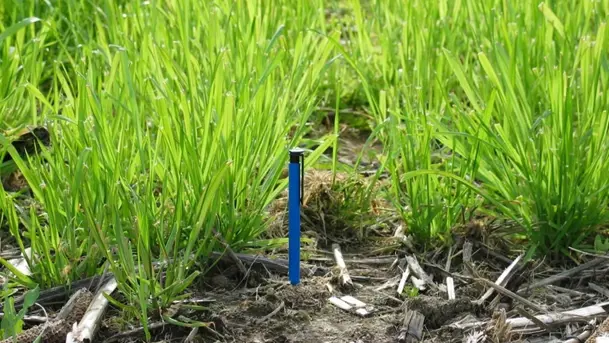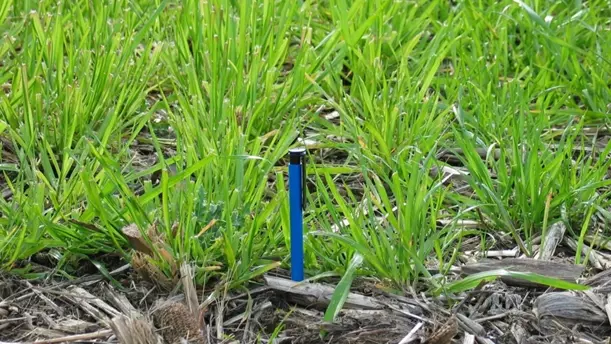Gibberellic Acid
7 min read
Gibberellic acid (GA3) is a natural hormone that promotes plant growth. When you use GA3 on pasture, it encourages growth by using the plant's energy, leading to more leaves and stems. This is especially useful during times when you expect less pasture growth. After applying GA3, you'll notice taller and slimmer leaves, sometimes a bit yellowed. To get the most out of GA3, you should apply it within 5 days after grazing and then graze again 3-4 weeks later. Be cautious: using GA3 can sometimes mean slower growth in the next grazing cycle. For best results, plan carefully and monitor the pasture's growth.
Gibberellic acid (GA3) is a naturally occurring hormone that is involved in regulating plant growth.
When applied to pasture, GA3 stimulates growth through mobilisation of plant energy reserves, resulting in leaf and stem elongation. The application of GA3 can be used as a tool to manipulate pasture growth and assist in matching feed supply and animal demand in the shoulders of the season when anticipated pasture growth is low.
Longer, narrower and more upright leaves can be seen within several days of application and are often accompanied by a slight yellowing of pastures.
At recommended application rates, initial DM responses typically range from 200-500 kg DM/ha four weeks after application. Responses are greatest when soil moisture and nutrients are not limiting.

Gibberellic acid treated pasture

Gibberellic acid untreated pasture
Responses to GA3 occur quickly, with visual signs occurring within several days of application. In contrast, responses to N generally take longer to become apparent and occur over a longer period. Therefore, the growth responses to GA3 and N are complimentary and result in a relatively consistent response throughout the regrowth period.
As GA3 affects the height of pasture, care should be taken when interpreting rising plate meter (RPM) measurements from GA3 treated pastures as there is the potential for overestimation of yield.
GA3 is best used to fill anticipated feed deficit. Pasture DM responses to GA3 are strongly influenced by season with the greatest responses occurring in late-winter/early-spring and autumn. Apply within 5 days after grazing and graze 3 to 4 weeks after treatment to capture the maximum response.
Applying GA3 in late winter/early spring appears to replace the requirement for accumulated long days to initiate stem elongation. As the number of long days increases, plants begin to produce sufficient GA3 themselves. As a result, there is very little response to GA3 applied in late spring and summer.
GA3 is typically applied:
To capture the maximum benefits of GA3, apply the following guidelines:
GA3 may be applied as a tactical response to a projected feed deficit or used strategically to enable changes to a farm system (e.g. earlier calving).
GA3 needs to be applied in anticipation of filling a feed deficit and, therefore, requires careful planning, including assessing the amount of extra feed that GA3 will grow and when it will become available for grazing.
Due to the limited application window, GA3 cannot be applied to the entire farm at once. Rotation length dictates the area that GA3 can be applied to each week. As a result, GA3 application will not result in a rapid increase in total farm cover. However, it will increase feed supply over time. This differs to the use of N where a large portion of the farm can have N applied at once to increase pasture cover over the whole platform.
Recommendations are to apply 8 g of active ingredient/ha plus non-ionic surfactant at label rates in 100-200 L water/ha. This can be applied effectively with conventional boom spraying equipment.
GA3 can be tank mixed with dissolved urea without affecting its stability, provided all solutions are used on the day of preparation (within 24hrs).
Do not spray if raining or rain is likely within 2 hours of spraying to ensure effective absorption onto leaf surfaces.
Limited evidence suggests that, under some circumstances, GA3 can cause a reduction in pasture growth in future grazing rotations (lag).
There is conflicting evidence around whether this effect can be influenced by management, in particular, N fertiliser application. Further research is needed in this space, however, it is important to be aware of the potential for reduced growth in future rounds and factor this into feed planning and management.
Despite the potential for a ‘lag’ effect, net dry matter responses to GA3 are generally positive. In addition, GA3 may provide value by ‘shifting’ feed from a period of surplus to a deficit, allowing for improved utilisation directly by the grazing animal.
Therefore, the greatest value from GA3 is likely to be offered:
Applications outside this period may still provide value but are reliant on achieving good DM yield responses to GA3 and minimising the opportunity for any subsequent depression in growth by:
The cost (c/kg DM) of dry matter responses to GA3 are highly affected by the net yield response to GA3 and also influenced by the method of application (self-applied or contractor).
There are several products available in New Zealand containing GA3. These vary slightly in cost, ranging from approximately $1 - $1.40/ g of active ingredient or $8 - $12/ha (incl. the cost of surfactant; as at October 2020).
At an average short-term response of approximately 300 kg DM/ha, the minimum cost of this response is 3 - 4 c/kg DM, however, this does not include any application costs.
Contractor charges to apply range between $30 - $50/ha (incl. chemical) or 10 - 17 c/kg DM.
These costs are dependent on achieving a good response to GA3, which can be highly variable. If the net yield response was instead only 150 kg DM/ha, the cost of additional feed generated increases to 20 – 33 c/kg DM.
If self-applying the chemical with your own spray equipment, consider the opportunity cost of labour, particularly through early lactation.
Replacing a small amount of N with GA3 in early spring and/or autumn may be an option for some to reduce N use while still influencing the timing of pasture supply. However, there is a limit to the quantity of N that can be replaced without negatively affecting pasture production. GA3 may be a tool in the toolbox, however it is unlikely to be a ‘silver bullet’ to reducing N use.
Both N fertiliser and GA3 are used to influence the pattern of pasture production in the shoulders of the season. As they are used for similar purposes, it seems intuitive that GA3 could be used to replace at least some of the N used within our farm systems.
However, to minimise subsequent depressions in growth, GA3 should not be applied to N deficient pastures. As a result, there is clearly a limit to the quantity of N that could potentially be replaced without having an adverse effect on pasture production.
An unpublished study at Lincoln University investigated the effect of replacing N with GA3 over two, four or six applications during the year (split between autumn and spring). Annual pasture yield declined at the rate at which N was removed, however, total yield remained greater than the control which received no N or GA3 (Miller, Bryant, Hague and Edwards unpublished).
With very little evidence of the effect of N application rate on net yield responses to GA3, it is difficult to provide definitive advice. However, when using GA3 to replace N, management needs to focus on reducing the opportunity for pastures to be N deficient. For some, this may mean applying smaller applications of N more frequently.
A plausible strategy may involve applying half the rate of N normally applied in combination with GA3 for one round pre-balance date and again in late autumn. Although the opportunities to reduce N use through this approach are relatively small, this may be enough for those operating at the borders of N restrictions.
Ball CC, Parsons AJ, Rasmussen S, Shaw C, Rowarth JS. 2012. Seasonal differences in the capacity of perennial ryegrass to respond to gibberellin explained. Proceedings of the New Zealand Grassland Association 183–187. DOI: 10.33584/jnzg.2012.74.2859
Edmeades DC. 2009. ProGibb® SG an independent assessment of the science.
Jiang S, Carey PL, Roberts A, Kerse G. 2011. Comparison of Three Plant Growth Regulators and Urea on a Canterbury Dairy Pasture. In: Currie; LD and Christensen CL (eds) Adding to the knowledge base for the nutrient manager: Occasional Report No. 24. Fertilizer and Lime Research Centre, Massey University: Palmerston North, New Zealand, 1–5
Matthew C, Hofmann WA, Osborne MA. 2009. Pasture response to gibberellins: A review and recommendations. New Zealand Journal of Agricultural Research 52: 213–225. DOI: 10.1080/00288230909510506
Parsons AJ, Rasmussen S, Liu Q, Xue H, Ball C, Shaw C. 2013. Plant growth - resource or strategy limited: Insights from responses to gibberellin. Grass and Forage Science 68: 577–588. DOI: 10.1111/gfs.12035
Stafford A, Guinto D. 2017. Trials amd tribulations with use of GA3 on pastures - what do longer term trials tell us? In: Currie; LD and Hedley MJ (eds) Occasional Report No. 30. Fertilizer and Lime Research Centre, Massey University: Palmerston North, 1–4
Van Rossum M. 2013. Dry matter production, nutritive value and botanical composition of a perennial ryegrass white clover pasture applied with GA and N in successive periods in autumn and spring. Lincoln University. DOI: 10.1007/s11104-010-0533-9.
Now’s the perfect time to check in, plan, and set up for a strong season. We’ve pulled together smart tips and tools to help you stay ahead all winter long.
Whether you prefer to read, listen, or download handy guides, we’ve got you covered with trusted tools to support your journey every step of the way.